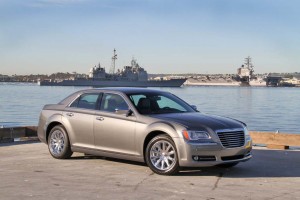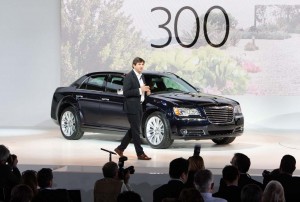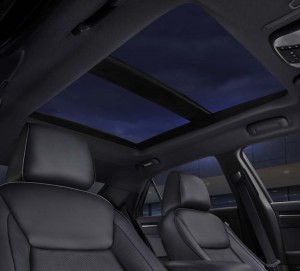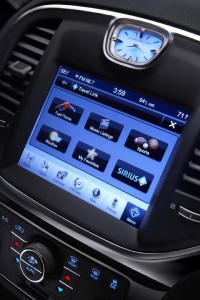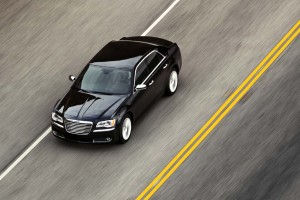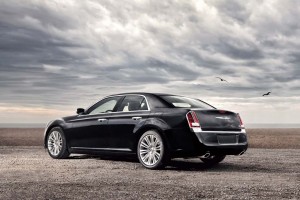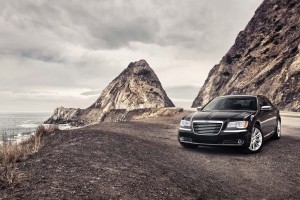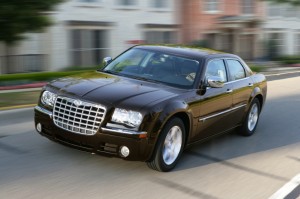Sure, safety sells, and fuel economy has certainly become a critical consideration for many American buyers. Performance matters, and there are plenty of folks influenced by the latest high-tech gadgets. But few things draw your attention as effectively as a good design.
And few cars in recent memory have been more effective at turning heads than the Chrysler 300, which made its show-stopping debut at the 2003 New York Auto Show – reaching production barely a year later. Starting from the bold, upright grille, the big sedan had an almost comic book presence that underscored Chrysler’s history of rolling out in-your-face designs.
Even today, the Chrysler 300 catches your eye. The exterior design, anyway. Unfortunately, the interior never matched that bold vision, with its jumble of cheap plastic bits and pieces. The 300 delivered an acceptable, if uninspiring, drive, and quality was a distinct problem, according to the likes of J.D. Power and Associates and Consumer Reports.
So, imagine the challenges faced by the Chrysler product development team assigned the task of redesigning this icon. They not only had to maintain its benchmark bravado but match that inside and out. They had to enhance the 300’s driving dynamics, improve fuel economy, enhance performance, fix endemic quality problems – and, oh, did we mention they had to do it all while Chrysler was in the midst of a financial collapse?
Considering everything on their plate, it might have been surprising enough to see a new version of the Chrysler 300 reach market at all. Indeed, for a while that seemed highly suspect. But somehow, the team pulled it off, and an all-new version of the big sedan will soon be reaching Chrysler showrooms around the country. But luckily, we didn’t have to wait.
A long day’s drive around San Diego, through the city, down along the coast and up into desert hill country, gave us a good sense of what the maker – and its new Italian partner, Fiat – has come up with. While the 2011 Chrysler 300 isn’t quite the show-stopper of the original, it’s still a stunning bit of styling, and this time, that applies both inside and out.
Sure, we have a few quibbles, and while we’ll have to wait to see if those quality issues have been resolved, we’re confident that Chrysler has come up with a solid hit that should get folks talking about a comeback for the smallest of the American automakers.
The updated design will be familiar to anyone who recognized the first-generation Chrysler 300, though it’s not quite as distinctive, especially from a direct side view. The crisp angles have been softened a bit. There’s a slight curve to the original, truck-like grille, and a steeper rake to the windshield. There’s a sweeping character line running almost nose-to-tail, and distinctively flared wheel arches. The overall look is decidedly more luxurious, a perception enhanced by the Audi-look LED running lamps that accent the headlights.
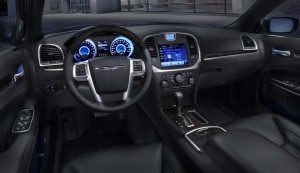
Other than the seats - which are comfortable but not supportive - the new Chrysler 300 interior is a major improvement over the old car.
Where Chrysler has really moved upscale is the interior, always the weak link in the 300’s chain. Gone is what designer Klaus Busse derisively refers to as the “battleship gray plastic” of the old car. In its place, the maker has adopted a delicious blend of sumptuously upscale materials all knitted together seamlessly and accented by brushed chrome.
The one-piece instrument panel is anchored by an 8-inch touchscreen display at the top of the center stack. The driver peers through the tastefully-appointed wheel at twin gauges illuminated in soft blue – a high-definition digital display between them.
The optional Garmin-designed navigation system, by the way, is extremely easy to use and even zooms in as you near a turn point to ensure you stay on your route.
It’s not all perfect. There are still a few too many pieces of flat black plastic that could’ve been better grained.
But our only serious complaint is with the new Chrysler 300’s seating. That’s because odd the seats are the pride and joy of Marketing Manager Bruce Velisek, something he insists the maker achieved only after benchmarking the absolute best-in-class – a class above, he adds, referring to Audi and Lexus models his team studied.
Unfortunately, we – and a number of colleagues we polled – found the seats strangely uncomfortable, especially if you drive the 300 even the slightest bit aggressively. You feel like you’re sitting atop, rather than sinking into, the cushions. And in a hard turn there’s simply nowhere enough bolstering to keep you in place.
That said, the new Chrysler 300 can handle corners in a manner you wouldn’t have dreamed of with the old car. That’s impressive when you realize the new sedan started out with the same basic suspension, but it underscores what a competent engineer can accomplish by tweaking bushings, adjusting alignment and modifying spring and damper rates.
Our preference was the new Touring package, which is standard with the Hemi All-wheel-drive model. But even the base suspension was a notable improvement and let us charge around the mountainous switchbacks down near the Mexican badlands east of San Diego without a worry.
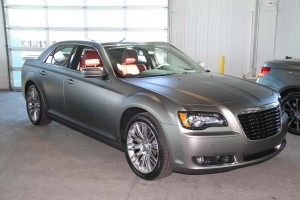
Chrysler will add a sportier 300S model - but it hasn't decided whether to offer this matte paint option, too.
And despite its heft – which weighs in at anywhere from 4,000 to 4,500 pounds, depending on configuration – the electro-hydraulic steering delivered a precise sense of road feel with just enough boost.
According to Velisek, a key goal for the 2011 Chrysler 300 was to minimize noise, vibration and harshness, and here the new sedan comes surprisingly close to Lexus and Buick territory without numbing the car into unconsciousness. If anything, we’d have loved to hear a wee bit more of that luxurious resonance when we stomped on the throttle and kicked the Hemi into action.
But it doesn’t take the big V8 to put the 2011 Chrysler 300 into motion.
Gone are the old base car’s anemic 2.7-liter V6 and the mid-range 3.5-liter 6-banger. In their place is a new 3.6-liter 24-valve Pentastar six. Rated against the smaller of the old engines it’s turning out an eye-popping 64% more power. To be fair, comparing it to the 3.5 uncovers an extra 42 ponies, at 292 horsepower and 260 pound-feet of torque. The engine is surprisingly quick and confident, turning 0 to 60 times in the mid-7-second range, impressive for a V6-powered full-size sedan.
It’s not often you’ll hear an autowriter say you’d be well off with a V6 when an 8 is available, but considering its performance and fuel economy, 18 City and 27 Highway, it’s hard to recommend the upgrade unless you really crave the extra power – or all-wheel-drive.
Unfortunately, you’ll have to go for the 5.7-liter Hemi to get AWD – though Chrysler brand boss Olivier Francois hints that may change at a later date. The V8 delivers a seriously solid 363 hp and 394 lb-ft of torque, and dropping 0 to 60 times below 6 seconds. As for top speed, we’re still waiting for the official answer, but our own experience showed the computer cutting fuel off as we nudged 120 mph. Mileage is 16/25 in rear-drive, 15/23 with AWD.
Both engines, incidentally, are currently being paired with an old 5-speed automatic. It’s acceptable, if dated, but for state-of-the-art you’ll have to wait until Chrysler comes through with an all-new ZF-supplied 8-speed gearbox that is expected to punch the Highway mileage of the V6 up and over the 30 mpg mark. It should also shift transparently.
There is still more to come for the Chrysler 300 line. We’re anticipating big news for the next-generation SRT-8, though no one is talking about it yet, preferring to focus on the base models.
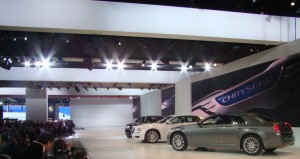
Chrysler's revamped 300 leads a resurgent lineup that includes the smaller 200, revised minivans and more to come.
We’re also waiting to get a chance to drive the all-new Chrysler 300S. That all-new designation refers to a sportier model that will expand the reach of the 300 line. It’s unclear whether performance will be tweaked but there’ll be a more European-style interior, including the more supportive seats we would like. At the San Diego preview, Chrysler even rolled out a 300S with a matte finish, though Velisek admits no decision has been made on whether to put it into production.
As with the rest of its line-up, Chrysler is trying to reposition the brand by offering an array of standard features normally not found on its models, especially base offerings. Yet at a starting price of $27,995 – slightly below last year’s base — you’ll get the uConnect hands-free system, a 15-way power driver’s seat, Sirius satellite radio, keyless entry and ignition and dual-zone automatic climate control. The Hemi-powered 300C will bump you up $7,000, but that includes the upgraded Touring suspension, Napa leather, heated front and rear seats, even heated and cooled cupholders. The top-of-the-line 300C AWD starts at $41,145.
Yes, you’re pushing into European luxury territory – but that means a compact with a small V6 and maybe, if you’re lucky, seat heaters.
The new 2011 Chrysler 300 line may not be the jaw-dropping design statement of the original, but it is much more the compleat automobile, top-to-bottom, inside-and-out. If this is what the “new” Chrysler has in store, it will definitely be worth putting the new sedan on your shopping list.

